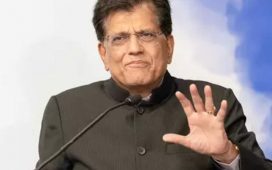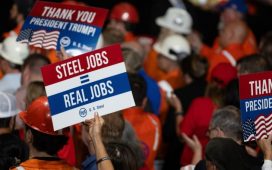Unlock the Editor’s Digest for free
Roula Khalaf, Editor of the FT, selects her favourite stories in this weekly newsletter.
US inflation is close to target, the unemployment rate is 4.3 per cent, and the economy is growing above its trend rate. Bad news can always appear — the August employment report is on Friday — but it looks like Jay Powell’s Federal Reserve has managed the economy about as well as one can imagine.
After 20 years of thinking about markets, however, I see the influence of luck everywhere. It is fair to wonder if Powell, rather than being a historically brilliant Fed chair, has just had the good fortune to be in charge when good things happened. Last week, my colleague Martin Sandbu articulated this possibility very neatly.
In his Jackson Hole speech, Powell attributed the post-pandemic inflation to distortions of both supply and demand, and put the subsequent disinflation down to the dissipation of those shocks, monetary policy moderating demand, and well-anchored inflation expectations. Anchored expectations were particularly important, he said, and the Fed’s vigilance in both current and past cycles has contributed to that.
Sandbu’s point is that if Powell dropped monetary policy from his disinflation explanation, the explanation would still work. Did monetary policy cool the labour market by reducing aggregate demand? Well, demand hasn’t weakened much, and the cooler labour market could be explained by the end of pandemic disruptions alone. Did the sharp increase in interest rates keep inflation expectations anchored, by moderating the behaviour of people who negotiate for wages and set prices? Well, market measures of expectations stabilised in the spring of 2021, before rate policy tightened.
I put this basic challenge — was Powell lucky, or good? — to four economists, and received an interesting range of responses. Paul Ashworth of Capital Economics thinks policy did cool demand but circumstances, particularly immigration, were more important:
I think the dropback in inflation was more due to easing supply shortages, particularly the immigration-led rebound in labour supply, rather than a weakening in demand that would be attributable to tighter monetary policy. But that doesn’t necessarily make Powell ‘lucky’ . . . weaker demand did play some role that the Fed can take the credit for.
Powell also pushes the line in his Jackson Hole speech that ‘prompt’ Fed hikes were, additionally, important because they kept inflation expectations well anchored. I’m less convinced by that supposed channel.
Jason Furman of Harvard is less sceptical about the anchoring effect, and notes that demand did cool in key sectors:
The soft landing would never have happened without the extraordinary tightening of monetary policy. Most importantly the Fed kept inflation expectations anchored by showing it was willing to act as aggressively as needed. In addition, the Fed reduced demand in certain sectors, especially construction, which ensured that as the fiscal stimulus and supply shocks faded there would not be another round of inflationary pressures.
Don Rissmiller of Strategas also emphasises the possibility of resurgent inflation:
We’re not quite at 2 per cent inflation. Maybe we’re close enough (I would argue we are) but there has been a lot of research on how the first part of the adjustment is easy and the ‘last mile’ is hard. So one reason [the economy] looks good is we haven’t actually finished the race . . .
In the 1970s [inflation ebbed as shocks subsided] as well. Inflation came down three times . . . the problem is it just went right back up three times (and accelerated).
Rissmiller thinks some credit for the lack of a resurgence goes to the Fed, for keeping expectations anchored with aggressive rate increases. But he thinks that there was also some luck involved in the soft landing. Immigration helped cool the labour market, for one thing. For another, the Fed was able to slow and then pause raising rates in part because there was a mini-financial crisis that was bad enough to scare everybody, but not bad enough to trigger a recession: the Silicon Valley Bank failure. “That looks more like luck than a plan,” Rissmiller says.
Adam Posen, president of the Peterson Institute, thinks that if the Fed had not increased rates, expectations would likely have become unanchored and inflation would have taken longer to come down. The long period of low inflation preceding the pandemic helped anchor expectations, too, as did parallel action by central banks globally. The surprising piece of good fortune was how little damage those rate increases did to the economy:
This occurred partly because the financial system and household and business balance sheets were so solid in 2019, and for the most part improved during Covid, which nobody foresaw.
This occurred partly because the neutral real interest rate went up for a variety of reasons during Covid, which I expect to persist. Therefore, the given policy was not as tight as the Fed and others thought it was, as seen in the loose credit conditions.
So, the Fed definitely did not cause the soft landing. Remember, chair Powell’s 2022 Jackson Hole speech was about readiness to inflict pain, and everyone pretty much expected that pain to come (myself included).
Posen, like the others, thinks the added labour supply from immigration helped, but he adds another positive shock to supply, from higher productivity:
What caused the soft landing was two unforeseen positive supply shocks since the start of 2022: a large surge in immigration, expanding the labour force and reducing labour costs; a rise in productivity growth above the pre-Covid trend.
No one saw either of these coming, and the Fed had absolutely zero influence on either of them. I would argue that the productivity growth increase was due to the reallocation of US workers to better/larger/more productive employers following the mass unemployment due to the Covid epidemic in the first half of 2020.
On balance, the soft landing would not have been possible without a lot of luck. Pandemic disruptions faded. A surge in immigration helped loosen the labour market. An unexpected productivity increase helped too. The SVB mini-crisis prompted a slowing of rate increases at what turned out the be just the right time. And a higher neutral interest rate meant that rates were never as tight as they appeared — meaning less economic damage for the same signalling of serious intent from the Fed. And in the background, a long period of disinflation and central bank vigilance before Covid made it more likely that inflation expectations would not run wild.
That said, Sandbu’s point that expectations were stable even before policy began to tighten is well taken, but not dispositive. By the time the Fed started to increase rates, many observers were howling that the central bank was “behind the curve”. Aggressive action thereafter calmed fears; so credit goes to the Fed there. Sandbu is right that we can’t be sure about this, but the basic picture makes sense.
One good read
Email us: robert.armstrong@ft.com and aiden.reiter@ft.com.
FT Unhedged podcast

Can’t get enough of Unhedged? Listen to our new podcast, for a 15-minute dive into the latest markets news and financial headlines, twice a week. Catch up on past editions of the newsletter here.







